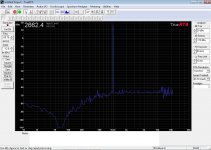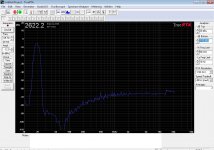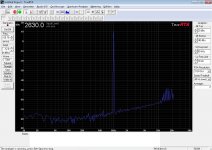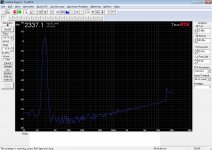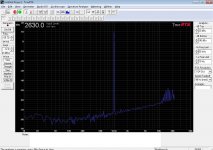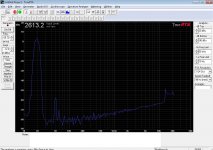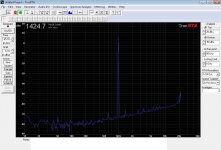Your countryman Christiaan Huygens, three hundred fifty years ago understood something you probably never will.
Last edited:
Oh no, a ad hominem attack, I'm trembling in my boots ... If, for lack of arguments based on science and mathematics, you resort to that you've officially lost the discussion.
Your statment about what I said just proves you have few expzriences with this chip... and I never say circuitry topology doesn't matter as well.
Again you are making things many people did already 10 to 30 years ago, so did I.
Please drop a picture of your board to have good advices from people that maid their homework already, ...we will be happy to help.
Merry Xmass þo all
Again you are making things many people did already 10 to 30 years ago, so did I.
Please drop a picture of your board to have good advices from people that maid their homework already, ...we will be happy to help.
Merry Xmass þo all
SPECTRUM
I2S source is a modified Technics PS-770D and a audio test CD from Amazon.
Signal is taken directly from the Sowter transformer secondary. No I/V resistor on the primaries, 6k8r across the secondaries (series connected).
However I have yet to investigate a sharp notch at 70Hz. Maybe its related to the low frequency dem clocking. This will be easy to prove when I change the dem oscillator clock capacitor.
I2S source is a modified Technics PS-770D and a audio test CD from Amazon.
Signal is taken directly from the Sowter transformer secondary. No I/V resistor on the primaries, 6k8r across the secondaries (series connected).
However I have yet to investigate a sharp notch at 70Hz. Maybe its related to the low frequency dem clocking. This will be easy to prove when I change the dem oscillator clock capacitor.
Attachments
Better to go for a modern DeltaSigma chip with EQ then... you don't want (really I mean) introduce filter there that has time issues...whatever a pass-band or a notch or anything more than first order for sub quantification noise :though it's not needed despite no over sampling : our ears are not in their 20 yo...
If passive I/V seems cool on the paper, one subjectivly has a better result with an active I/V without feedback. Buffers often are not really needed after but special personal conf.
If passive I/V seems cool on the paper, one subjectivly has a better result with an active I/V without feedback. Buffers often are not really needed after but special personal conf.
Please go and make a nuisance of yourself on another thread; your comments are of no interest to me.
You're wrong not to listen people that went here already... you 'are turning aroung in a glass with your traffo story... you try to reinvent a veiled wheel  (My TDA DAC is for sure sounding better than yours 🙂 )
(My TDA DAC is for sure sounding better than yours 🙂 )
Raimbow hui girl's (R H is a woman) dacs was for me 15 years ago with ad1865 and tda1541 dac and you want to give me some lessons with scopes picture from a badlayout... comon ! Go fisch ! They sounded like hell !
 (My TDA DAC is for sure sounding better than yours 🙂 )
(My TDA DAC is for sure sounding better than yours 🙂 )Raimbow hui girl's (R H is a woman) dacs was for me 15 years ago with ad1865 and tda1541 dac and you want to give me some lessons with scopes picture from a badlayout... comon ! Go fisch ! They sounded like hell !
Last edited:
MORE SCREENSHOTS
I decided to investigate the notch at 70Hz. So I swapped the Technics cd player for a modified Teac PD H01 slot in type from which I had already extracted the I2S signals. The Technics does not output I2S but left justified which means adding a jumper to Ian Canada's Fifo, whereas the Teac does output true I2S so the jumper was removed. The notch is absent. The peak at 50hz is a mains / grounding issue.
The second pair of screenshots were captured using a low cost USB dac fed from the Teac via Spdif for comparison purposes.
I decided to investigate the notch at 70Hz. So I swapped the Technics cd player for a modified Teac PD H01 slot in type from which I had already extracted the I2S signals. The Technics does not output I2S but left justified which means adding a jumper to Ian Canada's Fifo, whereas the Teac does output true I2S so the jumper was removed. The notch is absent. The peak at 50hz is a mains / grounding issue.
The second pair of screenshots were captured using a low cost USB dac fed from the Teac via Spdif for comparison purposes.
Attachments
Please go and make a nuisance of yourself on another thread; your comments are of no interest to me.
Said the fool off on another folly quest ...
Ridiculous.Everything matters. Balanced topologies give sterile sound.
More spectra
Image 1 is with the analyser input shorted. The same spike at 415Hz is present on all images and I have no idea where its from.
2 is of the usb dac - 5khz signal
3 is my dac with the resistor across the secondary of the Sowter transformer being about 6K
4 is my dac with a 1k load resistor. This reduces the output by 1/2 (6db) but cleans up the high end (above 12k)
5 is the usb dac at 1k
Image 1 is with the analyser input shorted. The same spike at 415Hz is present on all images and I have no idea where its from.
2 is of the usb dac - 5khz signal
3 is my dac with the resistor across the secondary of the Sowter transformer being about 6K
4 is my dac with a 1k load resistor. This reduces the output by 1/2 (6db) but cleans up the high end (above 12k)
5 is the usb dac at 1k
Attachments
Last edited:
- Home
- Source & Line
- Digital Line Level
- TDA1541A Dual differential MK1
